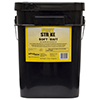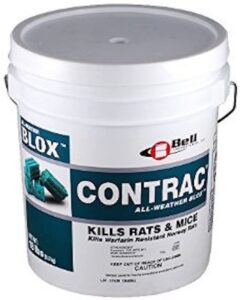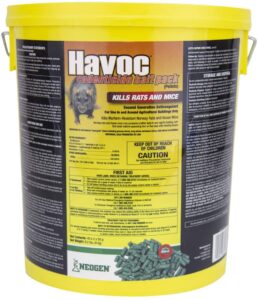Table of Contents
One common problem with chemical rodenticides is its strong smell. Pesticides have a repulsive odor that can cause respiratory problems. Also, the dead rat’s smell will add up to the gut-wrenching scent that may waft in your home. With this, I looked for rat poison that kills without odor so you can exterminate the pest without the hassle.
Unlike other rodenticides, those that didn’t leave a strong odor are gentler and safer to use. It’s also in bait form that the rat needs to ingest.
| RODENTICIDE | BRAND | EXPERT RATING | CHECK PRICE |
|---|---|---|---|
 | Our Top Pick! Bell Contrac Blox Rodenticide | Check Price | |
 | Neogen Havoc Rodenticide | Check Price | |
 | First Strike Soft Bait for Rats | Check Price | |
 | Kaput Rat and Mouse Bait | Check Price | |
 | Farnam Just One Bite II | Check Price |
What are rodenticides?
Rodenticides are a type of pesticide meant to kill rodents. It’s formulated as a bait that appeals to the taste of rats. This formula is designed to start killing even on a small amount, making it very potent and potentially dangerous for humans.
The best thing about rodenticides is it doesn’t leave any chemical smell on your home. It’s a rat poison that kills without odor, although it can’t help with the smell of dead rat if that’s what you’re thinking of. Rodenticides can kill rats, but once the dead bodies decompose, you’d have to clean up to prevent the smell from emanating from the remains.
Most rodenticides are packed with protein and sugar to entice the rats to feed on it. It’s basically rat poison masked as a tasty snack.
Rodenticides are not meant to be used in the open. You have to use a bait station where you’ll put the rodenticide. This will prevent children and non-target animals from accessing the poison.
Anticoagulant vs. non-anticoagulant rodenticides
Rodenticides are divided into two types: anticoagulant and non-anticoagulant.
Anticoagulant rodenticides
Anticoagulants interfere with the ability of the rodent’s blood to clot. Since it prevents blood clotting, it will lead to internal bleeding and eventual death. Specifically, it interferes with Vitamin K in the rat’s bloodstream, which plays a big factor in blood clotting.
Some examples of anticoagulants used in rodent poison are warfarin, bromadiolone, difethialone, and Brodifacoum, among others.
With the way anticoagulant works, the rat will die a slow and painful death.
Non-anticoagulant rodenticides
Unlike anticoagulants, the non-anticoagulants affect the nervous system of the rat. It alters the calcium levels in the bloodstream, which will lead to a slow death. For example, Bromethalin stops the central nervous system from creating energy, which will cause the nerve cells to swell. As the nerves press to the brain, the rat will become paralyzed and will soon die.
Some non-anticoagulants are single-dose, which means that it only takes one feeding to kill a rat. However, the likes of Cholecalciferol will require multiple ingestions to become lethal.
Other examples of non-anticoagulants are strychnine, zinc phosphide, thallium, and sodium fluoroacetate.
So which one is better? Both anticoagulants and non-anticoagulants work, but the latter only requires a small amount to kill the rat. This will let you save both bait and money, especially on massive infestations.
Benefits of using rodenticides
Unlike other pest control efforts, rodenticides offer a faster way to kill the rats. It’s also much safer for the people and pets around if used properly. The following are some of the perks of using this method:
✔️Cost-effective. A single-dose rodenticide will only require a small amount to become lethal among rats. With this, a single bait station can kill dozens, which will help you save money.
✔️Easy to use. Unlike chemical pesticides, rodenticides in the form of bait are easier to place. You simply have to put the chunk in the bait station and wait for the rats to forage. Some bait stations can be purchased with the poison already placed inside.
✔️Safer for kids. Rodenticides contained inside bait stations are safer for households with young children. Bait stations are designed to prevent small fingers from poking inside and touching the poison.
✔️Less effort. Once your bait is set, you just have to leave it alone and do its job. Make sure that you check any potential nesting site to dispose of dead rat bodies.
How to use rodenticides
Once you have a rat poison that kills without odor, the next thing to think about is how you’ll use it. When it comes to rats, you should avoid attaching your smell to the bait, or they will avoid it. You must follow these steps for the guaranteed kill:
Step 1. Get a bait station
You’re not supposed to put rodenticide chunk in the open. You must get a bait station or at least come up with a makeshift one.
Step 2. Fill it in
Open the bait station by pressing the release tab with your index finger. Once open, place the bait chunks inside. Make sure that you’re wearing rubber gloves as some rodenticides may cause skin irritation. Aside from that, your smell will attach to the bait and the station.
Step 3. Place it on the right spot
Once the bait station is all set, it’s time to place it around your house. Each bait station should be 8 to 12 feet apart for the best efficiency. Also, choose spots that are inaccessible to children and pets. Keep wearing the gloves until you’ve finished setting up the baits.
Step 4. Keep baiting
Keep filling in the baits for four consecutive days. Remember that rats would have to establish their foraging habits first, so don’t expect the pest to be gone overnight. Also, if you’re using a multiple-dose rodenticide, you will need to wait until the pests have fed on your bait multiple times. You must refill the bait regularly.
Step 5. Check for dead rats daily
A day after placing the baits, always check around your house for dead rats. For single-dose rodenticides, you can find weak rats the next day that are already on the brink of death. You can dispose of it right away to prevent decomposition and the bad smell.
Safety tips in using rodenticides
Although rodenticides are formulated to kill rats, it can also pose a risk to humans. Avoid any contact at all costs, especially to curious kids who might ingest the poison. To ensure that your rat extermination will succeed, you should keep the following in mind:
✔️Always wear protective gear. When it comes to rat poison, you should never take chances. Always wear gloves when handling the chunks and always wash your hands after.
✔️Patience is truly a virtue. Rats can bait-shy, so you have to be patient. One thing that you can do is getting them familiar with the bait station. You should add food first before putting the poison. This will let you kill more in the process.
✔️Read the label. Whatever pesticide you’re going to use, always read the label. Follow the instructions carefully and always pay attention to the manufacturer’s warning.
✔️Keep the bait tub sealed. Make sure that the bait container is always sealed and far from the reach of kids and pets. Keeping the bait sealed will also prevent it from going stale.
✔️Use gloves when disposing of rats. Rats are notorious carriers of various diseases. You must wear protective equipment when disposing of it, regardless if it’s still breathing or already decomposing.
✔️Mind the wildlife. Take note that rodenticides can also be poisonous to other wildlife. Make sure that stray and domestic animals won’t have access to the poison.
✔️Learn first aid. On the off chance that a child or a pet ingested the poison, you must know some first aid steps to prevent the poison’s spread in the body. Call 911 right away or rush the person to the hospital.
Rodenticide buying guide
When buying a rat poison that kills without odor, you must consider the following aspects:
Know your rodent
The first thing you have to consider is the type of rodent lurking in your home. You should look for long-acting, single-dose rodenticides that will start to kick in even at the smallest amount for large rats. Most potent rodenticides can kill rats and other pests.
Choose the right active ingredient
Next, you should decide whether you want an anticoagulant or non-anticoagulant formula. A non-anticoagulant rodenticide is more potent, which is ideal for large-scale infestations.
Remember that a 2nd generation rodenticides are more fast-acting than 1st generation formulas.
Dosage
Every rodenticide has specific doses that dictate how lethal its effects will be. High-dose rodenticides are ideal for large rat species. Due to their larger bodies, it will require more poison to start killing the critters.
The larger the droppings, the larger the rats will be. This means that you need to increase the poison dosage as well.
Safety precautions
Rodenticides should always indicate safety precautions to its label. It should include any potential allergic reactions, environmental effects, and other potential side effects.
Rodenticides are packed with toxins that should only be ingested by the pest you’re targeting. The manufacturer should also state clearly if the formula may cause secondary poisoning.
Value for money
Last but not the least, you should make sure that the rodenticide will yield results. This will give you the best value for money, especially if you’re purchasing multiple buckets of poison. A fast-acting, high-dose rodenticide will do the job for most infestations.
Rat Poison that Kills Without Odor – Top 5 Picks!
OUR #1 CHOICE
OUR TOP PICK: Bell Contrac Blox Rodenticide

Product Name: Bell Contrac Blox Rodenticide
Product Description: If you're looking for a rodenticide that works, you should get the Bell Contrac Blox Rodenticide. This rat poison is made of food-grade ingredients with a small amount of paraffin to make it palatable to rodents. Moreover, it works in both wet and dry conditions for a guaranteed kill. It's a single-dose anticoagulant that will kill the rat in just one feeding. To make the extermination possible, the yummy rat food is mixed with bromadiolone – a killer combo. The good thing about Bell Contrac Blox is that it's less toxic to non-target animals. It has less toxicity to non-rodent beings, even on primary and secondary poisoning. In the case of ingestion, the antidote to fight the poisoning effects is Vitamin K1, which can be bought on many drugstores.
Offer price: $$$
Availability: InStock
-
Potency
-
Formula
-
Value for Money
-
Speed
Overall
Summary
If you have warfarin-resistant Norway rats in your home, the Bell Contrac Blox will end the infestation. Its all-weather formulation also ensures that your bait will keep killing, rain, or shine.
Based on experience, this poison tends to have a repellent effect. Once some rats die, others tend to run away.
The only downside is that this rodenticide can’t be shipped to California due to some restrictions.
Pros
All-weather formula, works for both wet and dry conditions
Food-grade base ingredient
Less toxic to non-target animals
Cons
Can’t be shipped to California
RUNNERS-UP
Neogen Havoc Rodenticide
Another rodenticide that you can try is the Neogen Havoc. This one is a second-generation anticoagulant, which means it’s one of the most potent in the market. Each container has 40 packs, which is enough to eliminate a large population of rats.
Neogen Havoc targets rodents like mice and rats in just one feeding. As a single-dose formula, you can kill rats overnight. You can also find this rodenticide in different sizes like blocks, pellets, or meal baits to suit the size of rats you want to kill.
Moreover, this rodenticide contains Bitrex as an active ingredient. This is a non-target and child deterrent, which is added peace of mind. Aside from that, this is formulated with Brodifacoum that can kill warfarin-resistant Norway rats.
The good thing about the Havoc blocks is it’s formulated by livestock producers. It’s made palatable to attract the most bait-shy rats and kill them in just a single bite. In just four to five days, you’ll see dead rats all over your yard and home.
Within a week, you’ll see massive results with this rodenticide. This can be used outside, but you have to keep your pets away to prevent contact with the poison.
First Strike Soft Bait for Rats
For those who are targeting roof rats, Norway rats, house mice, and warfarin-resistant rodents, the First Strike Soft Bait is a good option. This has a lethal dose that can kill in just a single dose.
Moreover, this rodenticide uses difethialone as its active ingredient. You can this on station rods or in multiple pouch placements. This poison has high acceptance among rodents, which will prevent bait shyness and will produce more dead rats.
This one doesn’t have wax, which makes it more palatable and less suspicious to smart rats. It also has a good aroma that will attract rats to feed on it. This poison also lasts longer in storage.
Upon installation of this poison, you will see dead rats within four to five days. You can eliminate a large rodent population in less than two weeks with this poison.
Take note that this formula is so potent that it can also kill other wildlife, including squirrels. You should keep your pet away from the bait spots to prevent accidental poisoning. Ensure that all your food items and utensils are sealed to prevent secondary poisoning if infected rats roam on it.
Kaput Rat and Mouse Bait
If you want to save some bucks, you can try the Kaput Rat and Mouse Bait. This one uses warfarin as the main ingredient that will kill rats and even other wildlife like rabbits, squirrels, and voles.
Moreover, this poison should only be used inside for the best results within 50 feet of coverage. You should place two to eight packs of this poison with 15 to 30 feet distance. You should keep the baits filled for 10 days as Kaput isn’t a single-dose formula.
The good thing here is that Kaput is less toxic to non-target animals. In the case of accidental ingestion, the antidote is Vitamin K1, which can be bought commercially. Nevertheless, secondary poisoning is less likely and quite negligible in most households.
This has a green loose grain, which is palatable to rats. It mimics the natural seeds and grains they will usually found in the wild to reduce bait shyness. If kept sealed, these poison packs can last for 2 to 3 years.
However, since it’s using warfarin as its active ingredient, it will not work on resistant Norway rats. Other than that, it will work on most rat and mouse species.
Farnam Just One Bite II
If you’re looking for bait chunks, the Farnam Just One Bite II might be a smart choice. This 12-pound tub contains a single-dose formula with bromadiolone as the active ingredient. As a second-generation anticoagulant, this will kill rats fast and true to its name, in ‘just one bite’.
Aside from the poison, the chunks contain grains and seeds that make it attractive for rodents. Since it reduces bait shyness, you’ll see dead rats in as fast as 4 to 5 days upon the bait installation.
Another advantage with this bait is that each chunk has holes to suspend it on a wire. This is an effective method for roof rats and other areas where baits can’t be placed.
Aside from rats, this will also kill squirrels. The formula will kill both adult and young rats, which guarantees complete eradication of the pest population in your home. Also, it tends to reduce the stink of dead rats, which is a big plus.
Overall, this poison is very easy to use and can be used around agricultural buildings. The only downside is that it can’t be shipped in California due to local restrictions.
Frequently Asked Questions
Q: How long will it take for a rat to die when it eats poison?
A: It will take an average of three days for the rat to die upon ingesting the poison. Rats will also stop feeding once they’ve ingested the poison. This will reduce the possibility of secondary poisoning. Still, you should cover all food items and seal all utensils to prevent poisoning.
Q: How to tell if a rat is poisoned?
A: Poisoned rats that are on the brink of death will have labored breathing, weakness, and bleeding. Unfortunately, these are the same symptoms for pets that have ingested the poison.
Q: Where do rats die after eating poison?
A: Rats will not die in the bait station since the poison doesn’t take effect in an instant. You’ll never find dead rats on the bait if that’s what you’re expecting. Usually, the rat will go back to its nest, especially once it’s starting to feel the effects of the bait. One sign that the rat has died is once it starts smelling.
Q: Do rats suffer when they are poisoned?
A: If you’re curious, the answer is yes. Rats will die a slow and painful death when you poison them. Usually, it will take up to three days for the rat to die due to the poison’s effects and its complications. Anticoagulant-based baits will cause internal bleeding, which will not kill the rat instantly, making the pest suffer.
Q: Is there a safe rat poison?
A: Rat poisons are meant to be harmful to rats, but you can find formulas that are safe to use around children. Still, the fact that rat poisons are meant to kill means it’s not safe. You can try using diluted ammonia to kill some rats, but it doesn’t guarantee solid results.
Final words
Although rat poison that kills without odor doesn’t necessarily remove the stink of a dead carcass, it helps reduce the chemical smell of the extermination. The options I reviewed here will help you get rid of the pest without trapping or hunting them down. The baits will trick them into their own death in just a matter of days.
What do you think of the rat poison I reviewed above? Let me know below!





